Stocks, Commodities and Financial Markets, The Shape of Things to Come
Stock-Markets / Financial Markets 2010 Jul 25, 2010 - 08:58 PM GMTBy: Steve_Betts
 "What a cruel thing is war: to separate and destroy families and friends, and mar the purest joys and happiness God has granted us in this world; to fill our hearts with hatred instead of love for our neighbors, and to devastate the fair face of this beautiful world" --- Robert E. Lee, letter to his wife, 1864
"What a cruel thing is war: to separate and destroy families and friends, and mar the purest joys and happiness God has granted us in this world; to fill our hearts with hatred instead of love for our neighbors, and to devastate the fair face of this beautiful world" --- Robert E. Lee, letter to his wife, 1864
The special pay master, Kenneth R. Feinberg, let it be known that seventeen firms made “ill-advised” and “troublesome” payouts to their executives while they were receiving TARP funds. Altogether the payouts totaled US $1.6 billion and Mr. Feinberg added that the executives had no legal obligation to give the money back.
I have to wonder why the government would create more bureaucracy, at our expense, and yet not give it power to act and or correct wrong doings? Speaking of bureaucracy, this week Congress approved the banking reform bill which will add layers of laws on top of the layers that already exists, and of course all of this will require more expense and bigger government to oversee the new regulations. That won’t stop the banks from overvaluing bad assets or paying out billions of dollars in bonuses to top executives, and it won’t lead to more loans for the general public. In fact it won’t do anything that you couldn’t have done with the laws already on the books.
It occurs to me that we live in a world of accesses and no amount of government regulation will change that. Such periods have come and gone throughout history and the last one of such magnitude was way back in the 1920’s, and they even coined a name for it, the “Roaring Twenties”. Life was good and anything went. Then came the Crash of 1929 and the pendulum came swinging back to the other extreme as pendulums always do. The byproduct was the Great Depression of the 1930’s and the world war that followed. The Federal Reserve had only been existence for seventeen years and received much of the blame for the Depression with critics saying that its actions at the time were inappropriate. Being omnipotent the Fed did not handle the criticism well and made a conscious decision that bad times were to be avoided at all costs, Keynesian economic thought be damned.
Fast forward to the Greenspan era and 1999 with the peak of the tech bubble, and the Maestro decided to make the punchbowl overflow through the process of blowing bubbles. Real estate, bonds, the Dow, commodities and just about anything that moved was a viable target, but the biggest bubble of all went unnoticed. The public and private sector heaped boat load of debt upon boat load of debt and the Fed cheered them all on. More was better became the motto, to the point that innocent citizens mistook debt as an asset. Enter the wizard’s apprentice, Ben Bernanke, and he made it clear with his helicopter speech that it would continue to be business as usual. The battle lines were drawn: the Fed’s printing press versus the market forces. Could the Fed’s propensity to print avert a change in the primary trend from bullish to bearish? It had never been done before but the Fed was convinced that if it put the pedal to the metal, the good times would continue to roll.
In a normal economy excessive printing would have an adverse effect on the local fiat currency. The reason for that has to do with the very nature of fiat currency, i.e. it’s a piece of paper backed by nothing but a promise to pay with more of the same. There is no “value”, instead its worth is determined by the confidence you have in the entity doing the emitting. Confidence in the emitter is almost always directly related to quantity emitted, and I might add that it is an inverse relationship: the more currency printed the less confidence. Notice I said almost! The United States dollar is subject to a special circumstance since it has been generally recognized as the world’s reserve currency since the end of WW II. Given such a broad mandate the Fed was in a position to print much more than would generally be considered prudent, and print they did.
Events such as the Mexican, Russian, and Asian crisis, and 9/11 were all justification to print obscene amounts of currency, using each crisis as a justification. Nation building in Afghanistan and Iraq were also justifications for excessive printing and were even given special “off balance sheet” status, which is a politicians way of pretending that it really doesn’t count. In spite of the dollar’s special circumstance, the excesses began to take a toll and the dollar topped in late 2001, right around 9/11 as a matter of fact, and declined almost continuously until early 2008. Since then the dollar has tried to rally but the results have been less than modest.
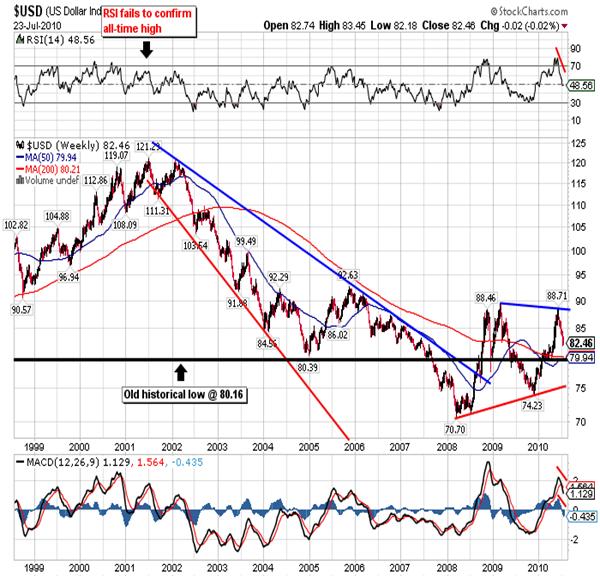
In a recent report I said to look at the United States as if it was a large company and the greenback was its common share. Given the weekly chart posted above, I suspect that in a normal world we’d have some unhappy shareholders. Of late the dollar experienced somewhat of a resurgence as it rallied off of the 2008 70.70 all-time low and made two attempts to move up through significant resistance at 89.97. In the process the dollar has seen its trading range compress and turn down. Here you can see the latest move lower:
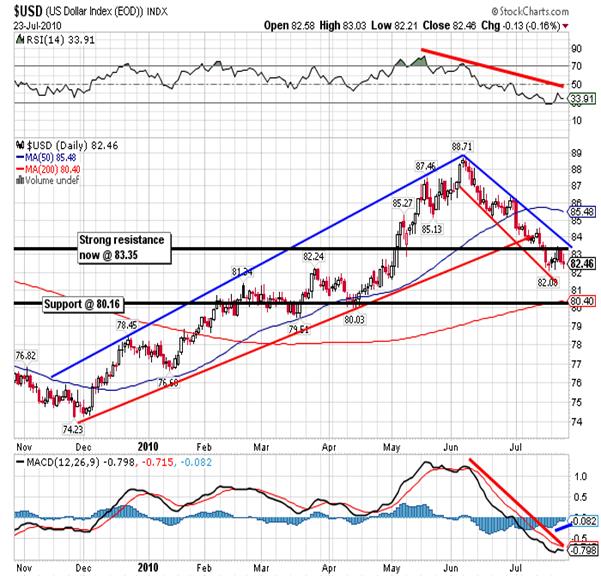
Note how the dollar broke down and out of the ascending secondary trend and the new secondary trend is now in sync with the downward sloping primary trend that stretches back to 2001. That means the deflationary effects are now discounted and the market is focusing on the new supply of fiat currency coming down the road.
The dollar ended its bear market reaction on June 7th with an 88.51 closing high and has fallen down to Friday’s 82.46 closing low. That is marginally above decent support at 82.44 and within reach of the 80.16 support from the old historic low. Strong resistance is now at 83.35. As the Fed’s reliance on the printing press increases the downward pressure on the dollar will increase and they’ll drag out the tired old refrain that a cheap dollar is good for the balance of trade. Unfortunately that never held true for the United States and it won’t be any different this time around either. We’ve already seen that the Fed is relying more and more on the printing press as a buyer of last resort for US debt, so it’s just a question of time before everyone loses what little faith they have left in the US to save the situation. I believe that once the US Dollar Index drops back below 80.16, the decline will accelerate and we’ll start to see real damage in other related markets like stocks and bonds. Smart money knows that all fiat currencies fall to zero sooner or later; history teaches us that.
With respect to the bond market, many are looking for a run to new highs as the Fed has implicitly guaranteed that rates will stay historically low for the foreseeable future. What’s more the Fed has let it slip out that it is studying the possibility of future stimuli “just in case”. Aside from that hell will freeze over before Moody’s or Standard & Poor’s ever downgrade the US; it’s much easier to throw stones at Spain and Greece than it is to bite the hand that feeds you. Unfortunately many people fail to comprehend that the Fed doesn’t set interest rates. Rather it’s the bond market that sets the rate, the rate is a function of risk, and it is not determined by some decision out of Washington. The fact that risk is increasing is seen in the international flow of funds, i.e., away from the US and to just about anywhere else. After minimal increases in US holdings at the beginning of the year, China and Japan have reduced holding of US dollar denominated instruments in April, May, and again in June so it’s not a coincidence that the dollar is now showing the strain.
A lot of lip service has been directed toward the bonds, projecting higher prices as the US keeps the rates historically low, but a look at the bond chart shows that it is under some strain:
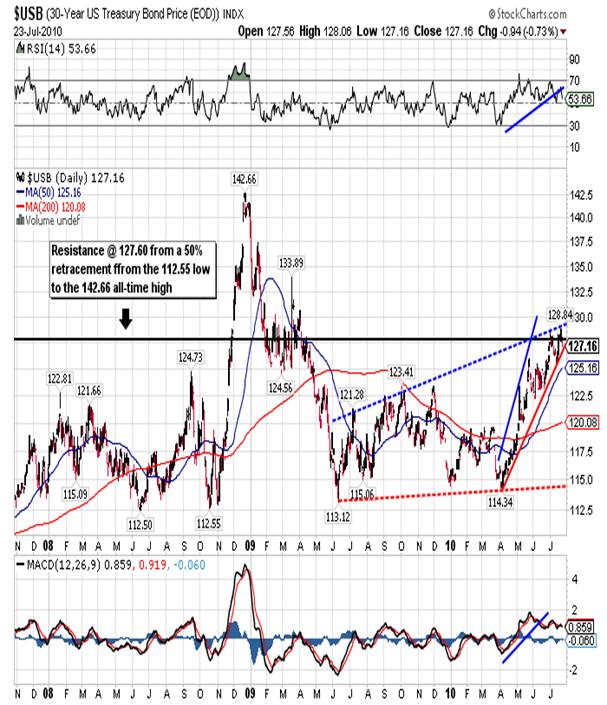
In particular note how the bond has failed to move back up above the resistance offered by the 50% retracement from the October 2008 low up to the December 2008 all-time high. On Friday the bond closed at 127.16 and back below the 127.60 resistance after a marginal break earlier in the week. The implications from the falling Treasury International Capital (TIC) flows and the falling dollar are clear, the Fed is now put itself into the position of buyer of last resort. All governments end up there sooner or later and the end result is written in the sand: complete collapse of the dollar, the bond, and stocks.
Stocks are perhaps the trickiest and most manipulated of markets because it’s the one that most investors can relate to. Almost everybody purchases a stock at one time or another, but relatively few venture into the bond market and even less delve into the FX market. I wrote a piece for Friday’s report that is worth repeating here since there appears to be a real divergence of opinion so here goes. Whenever you have conditions like we see today, it’s best to leave the guesswork to everybody else and focus only on what you really know. That’s why I kept the following chart as simple as possible. So here’s what I know:
- The Dow topped at 14,164.53 on October 9, 2007.
- The Dow fell from the October 9th all-time high to 6,469.95 on March 10, 2009 giving back 57.7% of its bull market gains accumulated over twenty-five years.
- From the March 10th low the Dow rallied up to 11,258 on April 26, 2010 recovering 61.8% of the previously mentioned losses.
- From that April 26th high the Dow has carved out a series of three lower highs (small horizontal black lines) and three lower lows (small horizontal green lines).
- The upper band of the current trading range (descending blue line) has yet to be violated although Friday’s close was right on it.
- Days with big losses have consistently heavier volume than days with big gains and that has been the case since the October 9, 2007 all-time high.
- The Dow did not confirm the all-time high in the Transports posted on May 26, 2008
- The Dow did not confirm the April 30, 2010 closing high in the Transports, and
- The Dow closed below its February lows but the Transports have not closed below their respective February low. This is yet another non-confirmation.
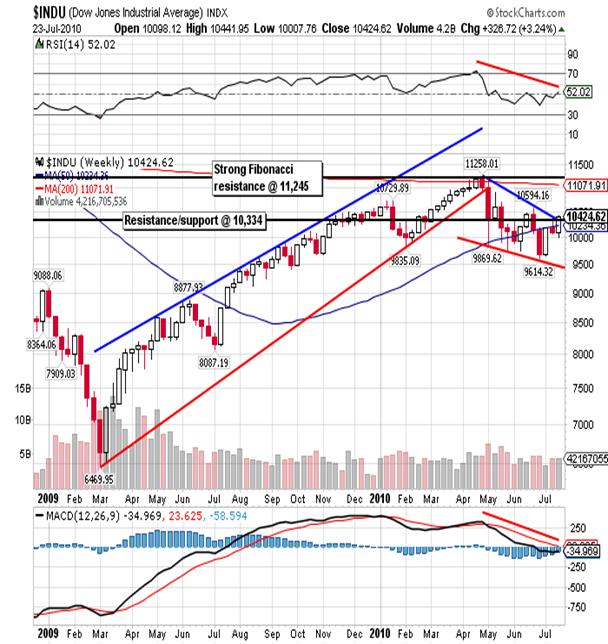
If I want to expand what I know to the US economy as a whole, I see that consumption continues to decline, housing continues to fall, and unemployment continues to be a real problem. I know that the US is a consumption based economy and that consumption was financed by sucking money from constantly rising housing prices. I also know that real wages are declining and savings is actually increasing in the US. Finally, I know the level of debt in the US is truly staggering and continues to increase daily.
With all that I know I can then ask what is in store over the coming months and years. Any solutions offered by the Fed are not intended for you. They are intended for Goldman Sachs and company, and the intention is that you pay for it. From the day the Fed was created the intention was to transfer immense amounts of wealth from the many to the few. Then about five years ago there was a change in policy and it was decided to transfer immense amounts of debt from the few to the many. The transfer was cleverly disguised as a “bailout”. The market recognized at the time that a large amount of liquidity would pour into it and so it rallied off of the March 2009 lows, gaining back 61.8% of the initial losses. In spite of the bailout unemployment, consumption and wages appear to be deteriorating again. Large companies are still reporting “great earnings”, partially due to the fact that bad debts never had to be written off. Small business, and that includes small banks, continue to suffer. Seventeen banks have been taken over by the FDIC in just the last two weeks, all while Goldman Sachs made provisions for another US $8 billion in bonuses.
The question is whether or not the economy can hold together given what the Fed is doing and any answer is pure conjecture. I have to believe that the creation and transfer of debt from the few to the many offers no real benefits to society. What’s more since the creation of most if not all debt is unproductive, i.e. offers no benefits to society, and debt must be paid, the markets will soon begin to discount the fact that no recovery can occur. Debt will act as a drag on the economy. States and municipalities that don’t have access to a printing press will seize up and eventually collapse. Small and medium sized businesses, crowded out of the credit market by the US government, will continue to lay off workers and cut back on production. The housing market will continue to suffer and that will drive even more small and medium sized banks to the wall. Try as they might and print as they will a dozen big companies with bloated balance sheets and access to unlimited amounts of fiat currency will not be able to sustain the US economy.
I believe the discount of bad things to come began when the Dow turned down on April 26th and the Transports went on to make an unconfirmed high on May 1st. The fact that the Dow made a series of lower highs and lower lows, allowing it to close below its February lows while the Transports failed to follow suit, is not a sign that the Dow will move to make new highs. Rather it is a warning to get out while the getting is good. Before the current reaction the Dow had fallen 1,644 points and as of Friday’s close it has gained back 810 points, just 12 points shy of a 50% retracement. Alone the way it has experienced an unprecedented twenty-one 90% days; eleven 90% down days and ten 90% up days. That is a phenomenal twenty-one 90% days out of sixty-one sessions going back to April 26th. That is not a sign of strength; rather it is instead a sign of internal disarray and confusion that can only end with a sudden and violent move down.
I don’t know whether the Dow can move higher from here but after last week’s reaction it is possible that either the Dow or the Transports will. Given what the daily charts look like, the odds favor the Dow moving above the June highs as it only needs another 30 points or so to get the job done. The Transports still have another 140 points to go. I don’t know where this reaction will fizzle out, but I suspect it will produce yet another non-confirmation, and then we’ll see both indexes turn back down. We are closing in on August and that’s when I expect to situation to take on a more dire appearance. Things will then deteriorate into September and by the time October rolls around even the most ardent bull will realize that he’s been taken to the slaughterhouse. By then Bernanke will be sending helicopters out to drop bags of money over major metropolitan areas but to no avail. Stocks will plummet and no amount of fiat currency will change that, and that’s why shorting the Dow is the only way to go (or the sidelines).
Gold is also suffering some adverse affects from Fed policies. It is important to understand that gold is a threat to everything the central banks stand for. Gold has been around for five thousand years and it cannot be created out of nothing or by government decree. It must be dug out of the earth at great expense and is a time honored store of wealth. On the other hand no fiat currency has ever stood for more than a century and fiat money is backed by nothing. The more they print the more their authority is diminished, and they know that. Therefore they will use any and every excuse to push the price of the yellow metal down and that’s where we are today. Gold made a new all-time high as recently as the middle of June and since then has slowly drifted lower. It is now twenty-three days off of that high closing on Friday at 1,189.30:
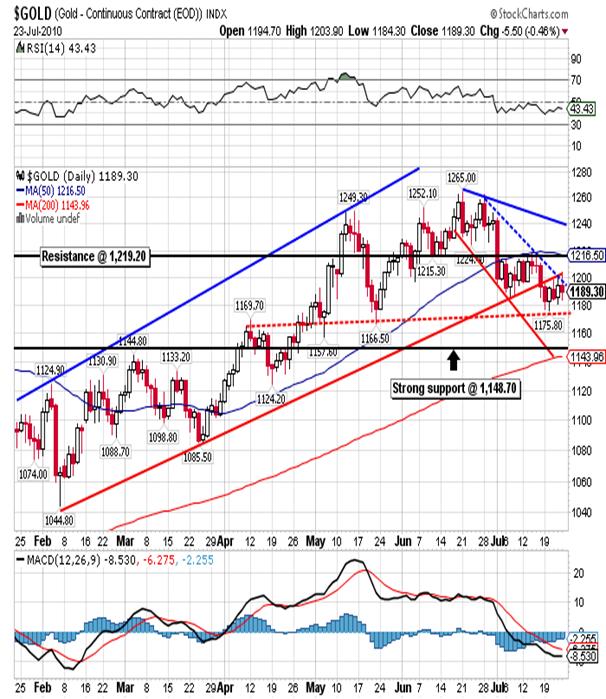
Right now some analysts are focusing on the fact that gold held support at 1,175.00 (red dashed line) but I am still looking for a lower low. A test of good support at 1,148.70 is probable and I think it will occur on or around the thirty day mark. Just below that you have the 200-dma so it is an area of good support. The 200-dma has not been violated since the 50-dma crossed above it back in February 2009 and any violation would indicate that much lower lows are coming down the road. Maybe even as low as 1,048.90.
Although not probable let’s assume the worst case scenario of a move down to 1,048.90 and try to remember that it doesn’t mean gold is bad and your positions should be abandoned. It simply means that a good buying is coming and investors should sit tight until it arrives. Central banks are gold’s best friend, and the more they print the better gold will perform over the long run. Make no mistake about it; the Federal Reserve will print obscene amounts of fiat paper until it produces the only possible result, a complete collapse of the dollar. The question I have is whether or not the rest of the world’s central banks will follow them over the cliff like the good sheep that they are. If they do there is no end to the amount that gold’s price can rise. We know that for more than a year it has consistently risen against every major currency in the world and in spite of the fact that the dollar has rallied for almost seven months. Gold has also rallied in spite of deflationary pressure and falling commodities prices, so those of you who think gold will fold up its tent and go home now that the dollar has topped, would be wise to think again.
I don’t know how low gold can go right now. With the dollar topping and heading lower gold will now complete the transformation into money. When that happens the bull market in gold will enter the third phase characterized by the general public piling into the gold market. To date gold is the play toy of commercial traders and institutions that can, at least over the short run, move the price around almost at will. As with any transformation process it takes time, and there will be a few hiccups along the way, and that’s what we are experiencing now. Manipulation exists and it will increase as the Fed desperately tries to maintain its grip on things. Unfortunately they’ve chosen to print their way out of trouble and that is the one solution guaranteed to fail. That failure will become evident to more and more people and that will drive the price of gold higher. That’s why I maintain that gold will not suffer any serious reactions until it reaches a minimum of 1,372.80, and to date I have yet to see anything that changes my mind.
In conclusion we seem to be living in a world of conflicting realities. The average American gets up every day and struggles to make ends meet and yet he turns on the TV and listens to educated people telling him that things are getting better. He doesn’t see it and none of his neighbors do either. He sees the city and state he lives in can’t make ends meet, his paycheck doesn’t buy what it used to, and he can’t give his children the things that they need. He’s being taxed to pay for the wars in Iraq and Afghanistan and for the war on drugs, and he knows all three wars are lost. He has serious doubts that social security will be there when he needs it and the new mandatory health care program will not be any better. He listens to politicians telling him that all these new programs will pay for themselves and yet he’s never seen a government program function as advertised. He can’t sleep at night wondering how bad things will get for his children and knowing he can never afford to retire.
It’s no wonder the Tea Party movement is gaining strength and people are finally realizing that Ron Paul is not just some crackpot whistling in the wind. Things will become quite interesting as this movement grows and begins to seriously challenge the status quo. I don’t know if the American people are up to the task. There is an entire generation of Americans that have never suffered and never passed through bad times. They had lofty expectations and are slowly coming to realize that those expectations may never be met. The big question is whether or not they have enough of the right stuff to force constructive change. Hell, I wonder if they’ll even recognize constructive change when they see it! We’re so used to having politicians lie to us, and so willing to except the lies as truth, that I wonder if we really know what is right and what isn’t. All of this will get sorted out over the next two years and new directions will be determined, and these directions will chart the course for the next decade if not the next generation. One thing is certain; it will be very interesting to watch.
[Please note that the new website at www.stockmarketbarometer.net will become operational this week. Also, note that you can contact us at our new e-mails, info@stockmarketbarometer.net (general inquiries regarding services), team@stockmarketbarometer.net (administrative issues) or analyst@stockmarketbarometer.net (any market related observations).]
By Steve BettsE-mail: analyst@stockmarketbarometer.net
Web site: www.stockmarketbarometer.net
The Stock Market Barometer: Properly Applied Information Is Power
Through the utilization of our service you'll begin to grasp that the market is a forward looking instrument. You'll cease to be a prisoner of the past and you'll stop looking to the financial news networks for answers that aren't there. The end result is an improvement in your trading account. Subscribers will enjoy forward looking Daily Reports that are not fixated on yesterday's news, complete with daily, weekly, and monthly charts. In addition, you'll have a password that allows access to historical information that is updated daily. Read a sample of our work, subscribe, and your service will begin the very next day
© 2010 Copyright The Stock Market Barometer- All Rights Reserved
Disclaimer: The above is a matter of opinion provided for general information purposes only and is not intended as investment advice. Information and analysis above are derived from sources and utilising methods believed to be reliable, but we cannot accept responsibility for any losses you may incur as a result of this analysis. Individuals should consult with their personal financial advisors.
© 2005-2022 http://www.MarketOracle.co.uk - The Market Oracle is a FREE Daily Financial Markets Analysis & Forecasting online publication.



